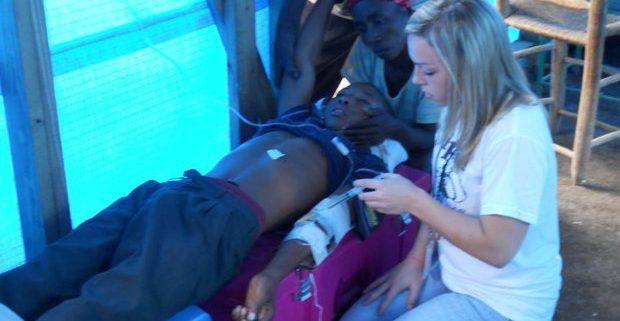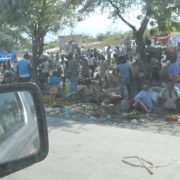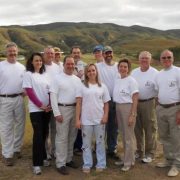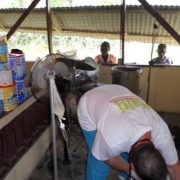Eleven Days in Haiti: Part 5 – Fewer Patients, More Serious Illness
This is part 5 of the “Eleven Days in Haiti” series that started here: https://fbcbridgeport.org/eleven-days-haiti-part-1-series-intro. Be sure to get caught up if you missed a prior post!
DAY 3—FEWER PATIENTS, MORE SERIOUS ILLNESS
Exhilaration describes the mood throughout much of the medical team as we headed back from the mountain village of Topya. We had held back a new soccer ball until all the patients were seen, then gave it to a dozen or so kids that were hanging around. They briefly clowned around for our cameras, then disappeared to enjoy some play time. To see the thrill on the faces of these energetic young people brought a pleasant end to an otherwise stressful day. We had driven several miles up a dirt road constructed by recent well-digging teams to this clinic site which was set up in a double version of the blue traditional Samaritan’s Purse tarp shelter. We had packed everything we could into a single van because two drivers and two interpreters were unable to make it to work today. Reportedly, the roads out of Port-au-Prince were blocked and closed due to protests surrounding the elections. The taxis or “tap-taps” were not running anyway as their operators were discouraged from working. None of this should make any difference to us as we headed away from the trouble and into the mountains, but it was obvious that the locals were uneasy. The apprehension soon spread to the rest of the team as we saw the seriousness of the day’s first patients.
Patient #1 was a teen-aged boy whom it was surmised had severe malaria, although typhoid or tetanus was considered as well.
He had been completely unresponsive to his parents since the night before and had to be carried into the clinic. His vitals were fairly normal, blood sugar was good, but he was incredibly weak. He could not open his mouth to take even liquids, so Dr. Dan wanted to start an IV, which he claims not to have done since he was a paramedic, perhaps 25 years ago. So since I thought this was to be a safer environment for Jenna to work, guess who Dan called on to help start the IV? She calmly did whatever was needed, from securing the patient so he did not flinch from the needle, to actually injecting medications into the port in the IV. Jenna, now “highly qualified” in IV procedures, also assisted in starting at least two other IV’s in equally ill patients. I might have assisted in these procedures but my services involved preparation of the IV medications that were required. We were short on certain drugs in liquid form, so I taught our local Haitian pharmacy techs to crush solid forms of the drug and mix with Pedialyte or Tylenol liquid to make sure the patient got the needed medication. I feel like this was one of my biggest contributions-to be able to provide some optional “work-arounds” in less-than-optimal situations and to suggest alternatives when preferred treatments were unavailable. The day did become less intense as the afternoon neared conclusion and the patient count was somewhat lower than yesterday, but the illnesses were much more serious in the mountains this day.
The ride back down the mountain was beautiful as the late afternoon sun reflected off the bay. The air was clear and calm and we could see many miles to the opposite shore near Port-au-Prince where many small fires were burning, some due to the political protests, others attributed to daily cooking or trash-burning. Dr. Vlad stopped the van at a nice overlook for photos. We photographed the bay, the mountains and each other. Vlad stopped a man walking home to take a group photo for us. He had to take one with each person’s camera and this worked well considering it was the first time the man had held a camera.
Scott and Janet got an email from the American embassy today warning of the unrest in Port-au-Prince and that the airport was closed. American Airlines suspended flights into and out of Haiti. Not sure what this means to us.
DAY 3 ADDENDUM As we left the mountain clinic, patient #1 was still mainly incoherent, but was able to take some liquids. We did what we could, but were not entirely confident that he would even survive. When the next team returned to this site the following week, his parents had walked several miles to the clinic just to say that their son had fully recovered.









